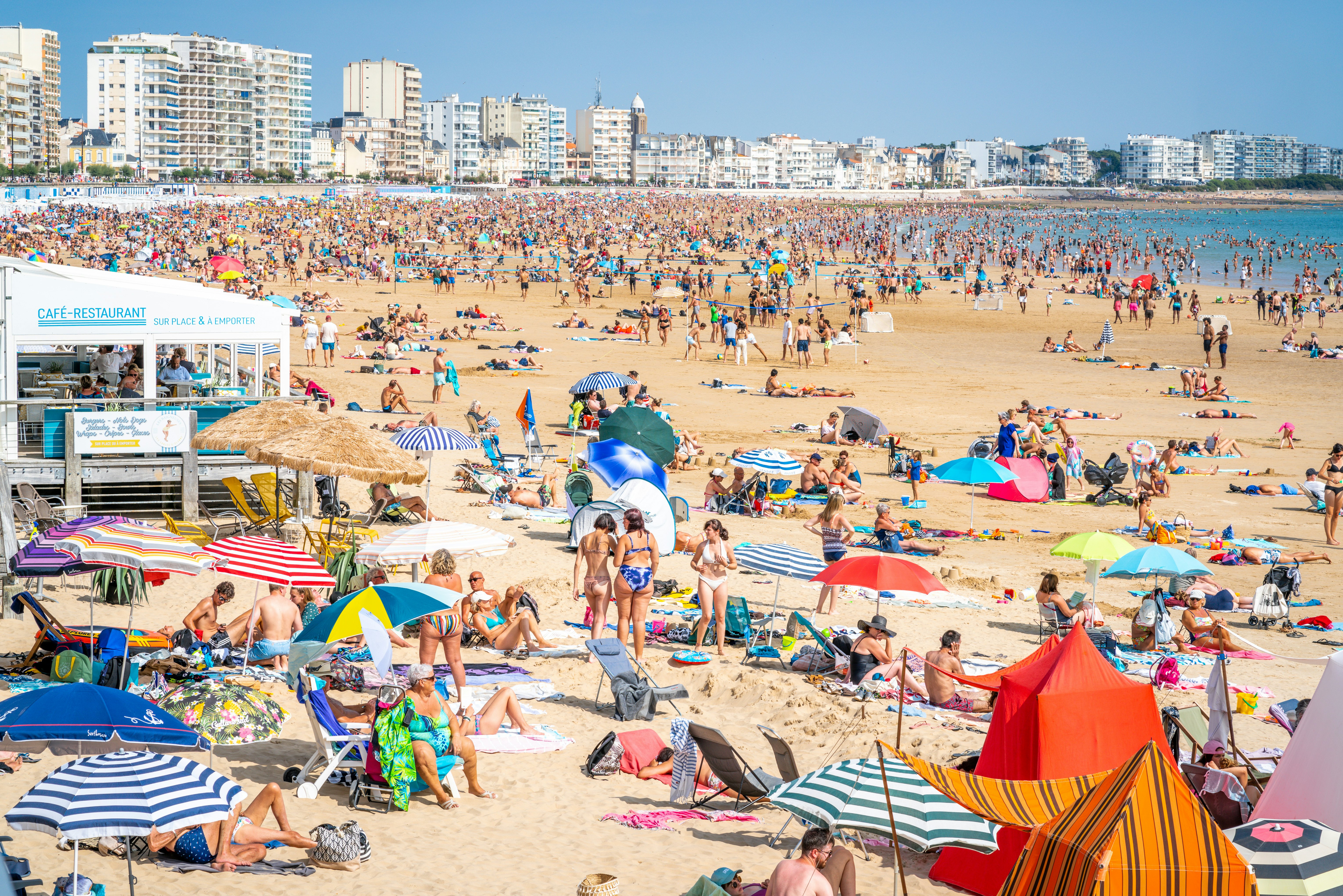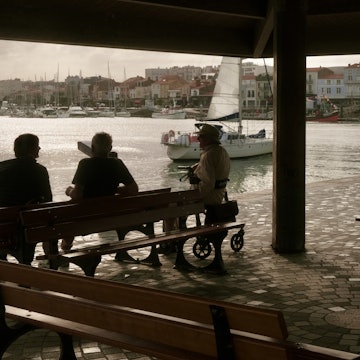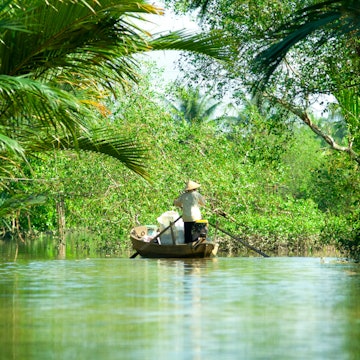
Escape the obvious in France: Swap the Côte d'Azur for the sunkissed Vendée coast in summer

Jul 24, 2023 • 6 min read

The beaches of Les Sables d’Olonne in the Vendée bask in plenty of sunshine year-round © Getty Images
Travel journalist James March is not immune to the charms of France's Côte d'Azur and gets why that may be your first choice for a beach holiday in France - but here's why he thinks you should consider visiting the Vendée region instead.
Ah, the French Riviera. Flanked on one side by the Mediterranean's glittering turquoise waters and golden arcing beaches while craggy cinematic mountains rise on the other, its glamorous coastal towns in between have attracted the world's high society and artistic glitterati every summer for well over a century.
Queen Victoria vacationed here in the 1880s, F Scott Fitzgerald wrote novels here in the 1920s and The Rolling Stones recorded albums here in the 1960s. And now, in the 21st century, the Côte d'Azur is as popular as ever. But France is a big country, and the Vendée on its sun-kissed Atlantic coast holds plenty of magic of its own and offers an enthralling alternative to one of the country's all-time most fabulous summer destinations.

The glamour and the glitz of the Côte d'Azur are well documented...
Running from lemon-filled Menton near the Italian border down towards the historic port city of Toulon (though there's no official boundary), the Côte d'Azur is a picturesque stretch of Mediterranean coast in the south of France populated by several well-known and well-heeled towns and cities.
From the blue and white parasols dotting Nice's crescent-shaped shores to the pristine beaches and sleek million-dollar yachts at Cannes and Saint-Tropez, there's an unmistakable allure to this corner of France and its popularity never fades. And that's also not a surprise when sunshine beams onto its 115 kilometers of coastline for 330 days of the year.
It's not just wide-eyed international visitors who visit either. So many Parisians love escaping the French capital every summer that the A6 highway linking Paris to the Riviera has been nicknamed the Autoroute du Soleil, meaning 'highway of the sun.'
All this movement adds up, however, and the Côte d'Azur now receives around 13 million visitors annually (pre-covid), meaning its towns become crowded and hotel rooms are snapped up well in advance. That glamour and popularity have also led to invariably high prices at those hotels and among its some 3000 restaurants. So as seductive as this famous slice of France is, there's an intriguing alternative option around 800km away on the west coast.

… but the Vendée offers something refreshingly different in summer
Spreading out between the cities of Nantes and La Rochelle on France's western coast, the Vendée is a small but splendid region to the south of Brittany's protruding peninsula. Though lined in places by rocky cliffs, this is a far cry from the wild North Atlantic. In fact, the Vendée sits in a mild microclimate and basks in the glow of 2500 annual hours of sunshine, with summers seeing very little rainfall.
With that lovely climate in mind, the beach is the place to start. Vast yawning sands stretch toward the horizon at Les Sables d'Olonne and Demoiselles Beach, while the dramatic corniche at St Gilles Croix-de-Vie conceals some glorious hidden coves that are often entirely vacant.
Above those coves, the Corniche Vendéenne is a breezy 3km walking trail that takes in some delightful views, particularly when passing by the handsome Grosse Terre lighthouse with the sweet smell of the green maritime pine trees for company and distant fishing boats trundling across the shimmering waters.

Those calm waters are available for exploring too, and Semvie Nautisme leads easy-going boating trips from St Gilles Croix-de-Vie's quaint harbor, offering guests the chance to steer their sailboats and enjoy some fantastic panoramic views.
Inland behind Saint Gilles, the landscape shifts dramatically. With its tree-less scenes of neat salt ponds, lonely hay bales, old stone cottages and elegant herons gliding overhead, the 500 hectares of flat salt marshes at Marais Salant Prédevie's a fascinating switch from the classic coastal scenes nearby and tours are available.
The variety of landscapes only flourishes further south, where e-bike tours from Libert E Trott start at Les Sables-d'Olonne's mast-filled harbor and wind out to the expansive coast before diving into the gentle dips and climbs of the lush green Forest of Olonne. Though the hills aren't taxing, the electric push of the bikes means lower stress on your legs and more time to appreciate the passing scenery.
For those wanting to explore the marshes further, Octopusglisse guides newcomers on a glide through those calm waters in a pirogue hawaienne (a type of outrigger canoe). And under the Vendéenne morning sun with swaying reeds and cute cottages passing by, it's a tranquil and almost therapeutic way to start a day.

Beyond the marshes, a more familiar French scene appears with acres of rolling green vineyards in neat rows. Wines from this region are known as 'Fiefs-vendéens' and come with their character, especially those whites like chenin and chardonnay with salty notes influenced by the nearby terroir. Explore some true fiefs-vendéens at Domaine St Nicolas, where tastings with gregarious owner Thierry Michon shouldn't be missed.
However, this coastal region's gastronomy is ruled by one product - the humble sardine. Back at Saint Gilles Croix-de-Vie, harvesting this small fish runs deep into the cultural fabric and few places are better than Le Banc de Sardines. A humble harbourside seafood shack, eating is limited to wooden benches outside and the sardines are caught fresh that morning and served alongside fluffy potatoes. With a glass of white wine, they're divine.
After this tantalizing taste, learn more about how fishing in St Gilles has evolved over the years with the exciting exhibits on show at the Escale Pêche Discovery Centre, while the L'Atelier de la Sardine offers more of a deep dive (no pun intended) into sardine fishing itself.
The Chemin de la Sardine ('Sardine Route') is a charming walking trail through some historic fishing neighborhoods and opens up the town's character a little more. A more wide-ranging walking tour takes place back in Les Sables-d'Olonne, where walking by its arcing beach and whitewashed villas like Palazzo Clementine are reminiscent of Nice's Promenade Anglais. They also take their gastronomy seriously here, especially at the gaudy Halles Centrales food hall and sublime Michelin-star restaurants like L'Abissiou.

Though the narrow lanes and pastel shutters of Les Sables' historic l'ile Penotte neighborhood would be achingly picturesque on their own, several walls are covered in the original seashell frescos of local artist Daniele Arnaud-Aubin, who has crafted colorful depictions of cats, ships, vampires, bats and other occasionally macabre images.
So while the Vendée doesn't have the glitzy status of the Cote d'Azur, its gorgeous weather twinned with some fabulous beaches, curious local quirks, fine food and a love of the outdoors makes it an enthralling alternative.
How to make it happen
Nantes Atlantique Airport is the nearest international airport, and trains from Nantes city center to St Gilles Croix-de-Vie take around 1hr 14min, while Les Sables d'Olonne is a little longer at 1hr 35min.
If you're starting your journey from Paris, then direct trains run from Gare Montparnasse to Nantes in two hours, where you can change toward either coastal town.
This corner of France is very popular with Parisians looking to escape the City of Light for a few days, so book ahead as early as possible.
James visited the Vendée on the invitation of Atout France. Lonely Planet contributors do not accept freebies in return for positive coverage.














